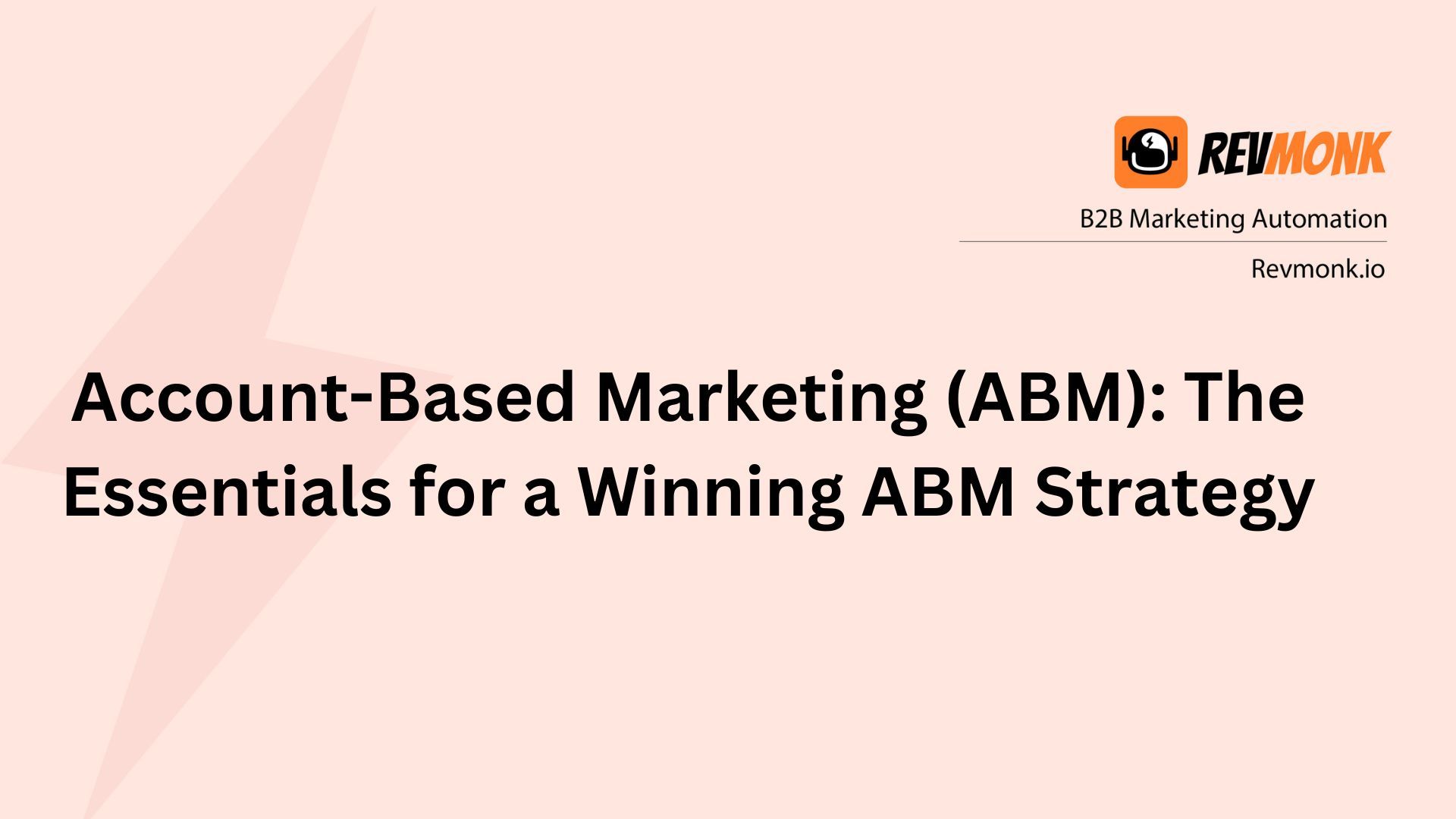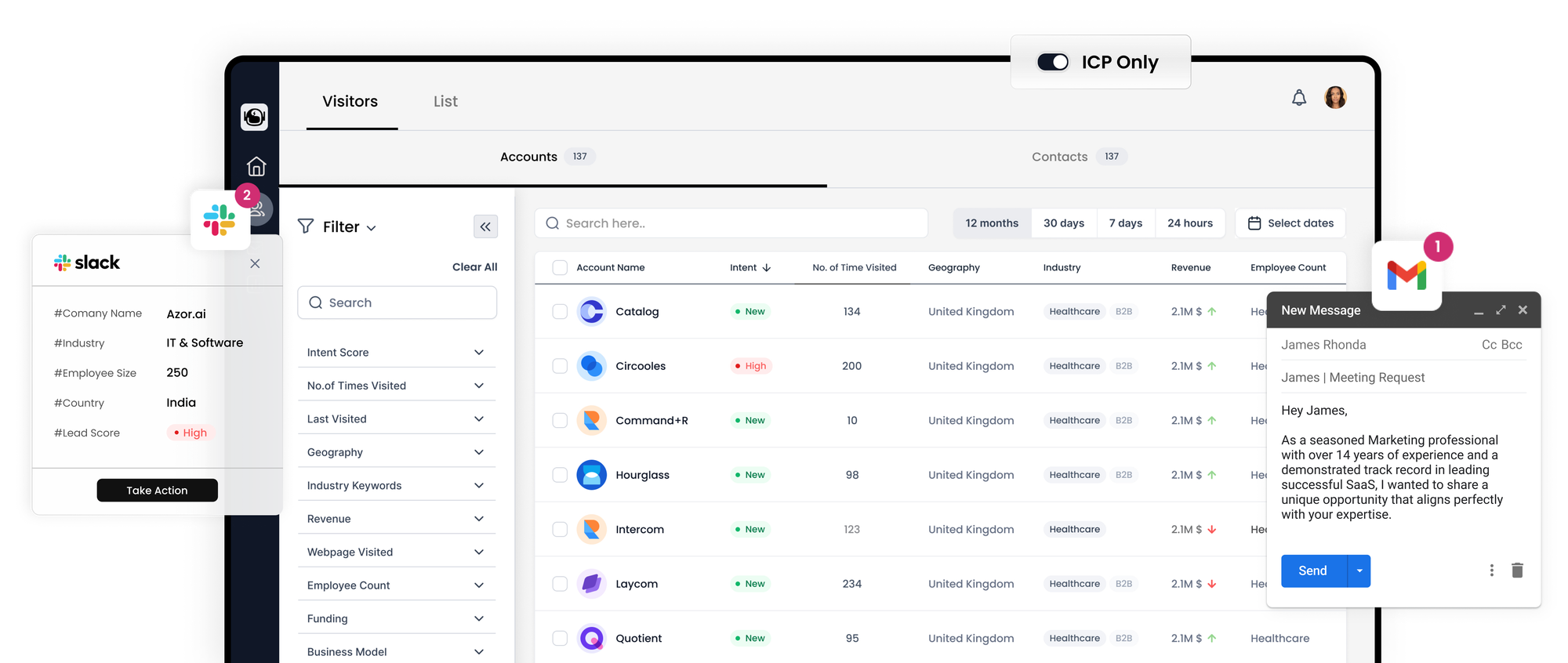Account-Based Marketing (ABM): The Essentials for a Winning ABM Strategy

Even two decades into its evolution, the prominence of account-based marketing continues to rise. In a recent survey, B2B marketing leaders unanimously concluded that account-based marketing yields superior pipeline growth, revenue expansion, and return on investment compared to alternative approaches.
However, there is a crucial caveat: without a robust data foundation, even the most meticulously crafted account-based marketing strategies are likely to falter.
To effectively unlock insights and engage customers on a larger scale, go-to-market (GTM) teams must infuse data and insights throughout their account-based marketing initiatives. They need to tailor their tactics to the most effective channels and keep a vigilant eye on the metrics that truly matter.

Defining Account-Based Marketing (ABM)
Account-based marketing (ABM) is the process of identifying well-suited, high-value accounts (not individual prospects) and tailoring customized messages that address their specific needs. Successful ABM hinges on personalization, but timing is equally pivotal.
Having enriched data about target accounts is vital, but it's equally critical to understand where these accounts stand in their buying journey. A highly personalized message, if delivered at the wrong moment, can be as ineffective as the generic "spray and pray" approach.
The typical ABM approach unfolds as follows:
1. Creating ideal customer profiles (ICPs) and identifying target customer accounts based on these profiles.
2. Applying these ICPs to craft pertinent messaging that addresses the top concerns of these accounts.
3. Disseminating this tailored messaging and engaging with leads through their preferred marketing channels on an ongoing basis to deepen customer relationships.
Naturally, every ABM campaign should be followed up with measurement of its success and iterative improvements. However, this post-campaign analysis is viewed as a separate exercise outside the core ABM workflow.
Incorporating Account-Based Sales (ABS)
Account-based marketing offers a scalable yet personalized approach that places significant emphasis on the pre-buying experience, priming leads for thoughtful interactions with the customer support and sales teams.
Crucially, account-based marketing achieves its maximum potential when complemented by an account-based selling (ABS) strategy. ABS seamlessly transitions leads that have traversed the ABM funnel into a sales environment. A failure to do so, simply dropping leads from the high-touch ABM approach into a conventional sales funnel, risks diminishing the chances of closing the sales cycle successfully.
Benefits of an Account-Based Marketing Strategy
Shifting from broad persona-based marketing to ABM campaigns necessitates a reevaluation of processes, structures, and how teams interact with the rest of the organization. Decision-makers should be prepared to invest a substantial amount of effort. While launching an account-based marketing strategy can be resource-intensive, the advantages demonstrate that the investment is highly worthwhile.
1. More Efficient Marketing Campaigns
ABM is an extraordinarily targeted strategy, eliminating the wastage of resources on unqualified leads. The ability to pinpoint well-matched accounts enhances the efficiency of campaigns. Marketers can be confident that only the most promising and sales-ready prospects enter their pipeline.
2. Optimized Sales
Personalization stands out as the paramount advantage of account-based marketing. When you deliver highly targeted marketing content to an account, customers and prospects feel understood, accelerating the sales process.
3. Enhanced Retention
An account-based marketing strategy can be tailored to both secure new business from target accounts and nurture existing customers, fostering a "land-and-expand" approach. This becomes increasingly valuable in a market where saturation rises and customer acquisition costs continue to escalate.
4. Improved GTM Collaboration
Account-based marketing is not confined to marketing alone; it's a company-wide strategy that demands alignment between sales and marketing to accurately identify and target agreed-upon accounts. This alignment reduces friction over lead quality, as both teams work together toward common objectives.
Embracing ABM can serve as a foundation for companies to establish a modern go-to-market approach, drawing every business unit—from the C-suite to customer support—into alignment around a strategy that drives account sales and retention through exceptional customer experiences.
The Cornerstone of Success: Harnessing Data for Account-Based Marketing
Effective account-based marketing (ABM) hinges on the bedrock of robust data. It's imperative to consider the quality, comprehensiveness, and source of your data because ABM driven by faulty or incomplete data will not yield the desired outcomes. While some platforms rely on customer relationship management (CRM) data, which can often be riddled with gaps and inaccuracies, more advanced platforms empower marketers to blend first-party data with a constantly updated third-party data source. This integration significantly enhances the depth, breadth, and overall effectiveness of resulting ABM campaigns.
Here are four ways to leverage data in shaping your ABM strategy:
1. Crafting Your List of Target Accounts
A pivotal component of ABM strategy and campaigns is the selection of target accounts. The crux of identifying and focusing on high-value accounts lies in the development of an ideal customer profile (ICP).
Analyze your contact and customer database to discern the characteristics shared by your most valuable customers. These traits may encompass:
- Industry
- Company size
- Revenue
- Location
- Average purchase size
- Tech stack
Your ICP serves as the blueprint for pinpointing and targeting accounts with similar attributes.
2. Identifying Prospects Currently in the Market
Timing plays a pivotal role for customers contemplating significant purchases.
A company may align perfectly with your ICP, but if the timing isn't right—perhaps they've recently adopted a competitor's solution or are grappling with financial challenges—they won't be inclined to purchase your product.
Intent data can illuminate which entities are actively seeking a solution akin to yours. Marketers can prioritize "high-intent" accounts currently in the market for a purchase, channeling them directly to the sales team for proactive engagement. Conversely, accounts displaying low intent can be funneled into a nurture campaign, ideally before their competitors make inroads.
First-party data can also provide crucial insights about anonymous website visitors. Individuals who have perused high-value pages on your company's website make excellent prospects for account-based marketing since they are already acquainted with your product and potentially interested in a purchase.
3. Ensuring Comprehensive Coverage
Account coverage refers to the ability to establish a presence within a substantial number of key accounts. It's important to remember that while accounts make purchasing decisions, it's individuals within those accounts who wield decision-making power. Identifying your target accounts is a crucial step, but it's equally vital to establish contact with key stakeholders within them.
There are two primary types of data required for optimal account coverage:
- Business structure data: This pertains to insights about a company's organizational hierarchy and decision-making structure. Organizational charts are invaluable in identifying key stakeholders within an account, allowing you to connect with every decision-maker, buying committee member, and company advocate.
- Contact data: Accurate contact information for key stakeholders is indispensable. Direct phone lines (direct dials) are particularly vital, especially when targeting higher-level decision-makers.
4. Leveraging Intent Data to Inform Content Strategy (Again)
Once you've identified the accounts and individuals to target, you can employ intent data to customize your content offerings. For instance, when a prospect exhibits minimal intent to make a purchase, you can nurture them with thought leadership materials that elucidate a relevant problem and potential solutions.
Conversely, if a prospect displays strong intent to purchase, you can deliver content focused on solutions and include direct response offers like "request a demo" or "start your free trial." The more pertinent and personalized your message aligns with their current circumstances, the greater the likelihood of conversion.
Implementing Your ABM Strategy Across These Four Marketing Channels
Ready to put your newly crafted ABM strategy into action? Start by leveraging these four key marketing channels to maximize its effectiveness.
1. Events: Both Virtual and In-Person
Apply an ABM approach to your in-person events by extending personalized invitations to key prospects from your target accounts. Enhance the experience with bespoke gifts and swag items that align with your knowledge about each attendee. After the event, continue to tailor your follow-up communications to further nurture and strengthen those business relationships.
For virtual events and webinars, employ the same level of personalization. Craft individualized invitations and experiences for each target account. Digital events can provide opportunities for even deeper connections, as one-on-one conversations can be facilitated more easily in a private online setting, without the logistical complexities of in-person events. Don't forget to complement your virtual events with customized gifts and personalized post-event follow-up, just as you would with in-person ABM events.
2. Email Marketing
Account-based email marketing revolves around creating and sending customized messages to each company and individual, as opposed to the one-size-fits-all approach often associated with volume-based marketing. However, this doesn't necessitate manual effort for every interaction. Leverage marketing automation to trigger email sequences, seamlessly transfer essential account and behavioral data between marketing tools, and surface insights to craft highly personalized emails for crucial accounts, even at scale.
3. Paid Advertising
Pay-per-click (PPC) ads and sponsored social media posts are potent tools for capturing the attention of target accounts beyond your owned media channels. Many social platforms offer robust customization options for ads, allowing you to tailor your content based on factors such as a person's company, role, and industry. Technologies like IP targeting and retargeting enable efficient budget allocation by focusing on accounts that have previously engaged with your brand or are part of your shortlist of target companies.
4. On-Site Personalization
Your ABM strategy extends to your website's visitor experience. Implement modern A/B testing tools for real-time experimentation to identify and adapt content to align with each prospect's specific interests and needs. Follow up with personalized engagement efforts designed to enhance retention and build stronger connections with your most significant accounts.
Measuring and Analyzing ABM Performance
The success of your ABM strategy hinges on your ability to measure its effectiveness and identify areas for improvement. To gauge the impact of your tactics, begin by defining success criteria specific to your team's objectives.
Your ABM objectives may encompass:
1. Developing new revenue streams
2. Generating fresh sales opportunities
3. Reviving stalled opportunities
4. Enhancing customer lifetime value (CLV)
5. Establishing measurable retention
To assess performance against these goals, compare key performance indicators (KPIs) from your prior sales and marketing activities with results from your ABM initiatives. Valuable metrics to consider include:
- Number of opportunities
- Number of engaged target accounts
- Number of marketing-qualified leads (MQLs)
- Average deal size
- Win rate
- Deal-to-close time
Given the multifaceted nature of your ABM efforts, it's essential to understand the impact of each approach and channel to effectively allocate your resources. When evaluating the performance of specific ABM campaigns, consider factors such as:
- Content consumption: Are target accounts actively engaging with the content and campaigns you're delivering? Monitor metrics like reading duration and interaction levels. Identify which elements resonate most with your audience and refine accordingly.
- Email engagement: If you've incorporated email marketing, assess whether the customized messages you're sending are being opened, read, and acted upon. Analyze which aspects of your emails drive engagement and identify areas for improvement.
- Social media activity: Evaluate your engagement with target accounts on their preferred social media platforms. Measure the rate at which they interact by sharing, liking, and commenting on your content.
- Click-through rate (CTR): Track CTR across ads, in-content buttons, and links to gauge the impact and effectiveness of your messaging and targeting. Determine which elements drive the most conversions and optimize accordingly.
